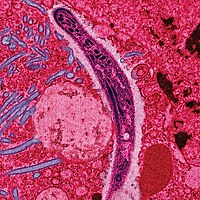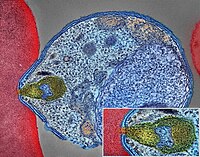
Malaria Pigment Crystals: The Achilles′ Heel of the Malaria Parasite
Sign Up to like & getrecommendations! Published in 2021 at "Chemmedchem"
DOI: 10.1002/cmdc.202000895
Abstract: The biogenic formation of hemozoin crystals, a crucial process in heme detoxification by the malaria parasite, is reviewed as an antimalarial drug target. We first focus on the in‐vivo formation of hemozoin. A model is… read more here.
Keywords: malaria parasite; digestive vacuole; crystals achilles; hemozoin ... See more keywords

Live and Let Dye: Visualizing the Cellular Compartments of the Malaria Parasite Plasmodium falciparum
Sign Up to like & getrecommendations! Published in 2019 at "Cytometry Part A"
DOI: 10.1002/cyto.a.23927
Abstract: Malaria remains one of the deadliest diseases worldwide and it is caused by the protozoan parasite Plasmodium spp. Parasite visualization is an important tool for the correct detection of malarial cases but also to understand… read more here.
Keywords: malaria parasite; parasite plasmodium; live let; let dye ... See more keywords

Multistage inhibitors of the malaria parasite: Emerging hope for chemoprotection and malaria eradication
Sign Up to like & getrecommendations! Published in 2018 at "Medicinal Research Reviews"
DOI: 10.1002/med.21486
Abstract: Over time, several exciting advances have been made in the treatment and prevention of malaria; however, this devastating disease continues to be a major global health problem and affects millions of people every year. Notably,… read more here.
Keywords: multistage inhibitors; malaria parasite; malaria eradication; malaria ... See more keywords

Application of gamma irradiation knowledge in tissue sterilisation: inactivation of malaria parasite
Sign Up to like & getrecommendations! Published in 2018 at "Cell and Tissue Banking"
DOI: 10.1007/s10561-018-9683-4
Abstract: Malaria is one of the exclusion criteria used in selecting tissue donors and the absence of this information can lead to rejection of tissues for transplant. The studies on the malaria parasite have been confined… read more here.
Keywords: sterilisation; inactivation malaria; malaria parasite; application gamma ... See more keywords

Rhoptry neck protein 11 has crucial roles during malaria parasite sporozoite invasion of salivary glands and hepatocytes.
Sign Up to like & getrecommendations! Published in 2019 at "International journal for parasitology"
DOI: 10.1016/j.ijpara.2019.05.001
Abstract: The malaria parasite sporozoite sequentially invades mosquito salivary glands and mammalian hepatocytes; and is the Plasmodium lifecycle infective form mediating parasite transmission by the mosquito vector. The identification of several sporozoite-specific secretory proteins involved in… read more here.
Keywords: malaria parasite; invasion; neck protein; parasite sporozoite ... See more keywords

A Cas9 transgenic Plasmodium yoelii parasite for efficient gene editing.
Sign Up to like & getrecommendations! Published in 2018 at "Molecular and biochemical parasitology"
DOI: 10.1016/j.molbiopara.2018.04.003
Abstract: The RNA-guided endonuclease Cas9 has applied as an efficient gene-editing method in malaria parasite Plasmodium. However, the size (4.2 kb) of the commonly used Cas9 from Streptococcus pyogenes (SpCas9) limits its utility for genome editing in… read more here.
Keywords: malaria parasite; gene editing; efficient gene; plasmodium ... See more keywords

Method for the separation of mitochondria and apicoplast from the malaria parasite Plasmodium falciparum.
Sign Up to like & getrecommendations! Published in 2019 at "Parasitology international"
DOI: 10.1016/j.parint.2018.12.003
Abstract: The growth and the survival of the human malaria parasite Plasmodium falciparum are critically dependent on the functions of the two organelles - the mitochondrion and the apicoplast. However, these two organelles have been known… read more here.
Keywords: malaria parasite; parasite plasmodium; separation; plasmodium falciparum ... See more keywords

Targeting Plasmodium Proteases to Block Malaria Parasite Escape and Entry.
Sign Up to like & getrecommendations! Published in 2018 at "Trends in parasitology"
DOI: 10.1016/j.pt.2017.11.012
Abstract: Proliferation of malaria parasites in a host requires mechanisms to spread between red blood cells (RBCs). We discuss here the implications for biology and antimalarial drug development of companion studies that establish the requirement of… read more here.
Keywords: malaria parasite; plasmodium proteases; block malaria; plasmodium ... See more keywords

Plasmodium's bottomless pit: properties and functions of the malaria parasite's digestive vacuole.
Sign Up to like & getrecommendations! Published in 2022 at "Trends in parasitology"
DOI: 10.1016/j.pt.2022.02.010
Abstract: During intraerythrocytic growth, the human malaria parasite Plasmodium falciparum degrades up to 80% of the host cell's hemoglobin inside an acidified organelle called the digestive vacuole (DV). Here, the globin chains are broken down by… read more here.
Keywords: digestive vacuole; malaria parasite; plasmodium bottomless; bottomless pit ... See more keywords

Current status of experimental models for the study of malaria
Sign Up to like & getrecommendations! Published in 2022 at "Parasitology"
DOI: 10.1017/s0031182021002134
Abstract: Abstract Infection by malaria parasites (Plasmodium spp.) remains one of the leading causes of morbidity and mortality, especially in tropical regions of the world. Despite the availability of malaria control tools such as integrated vector… read more here.
Keywords: animal models; status experimental; malaria parasite; biology ... See more keywords

Ozonide antimalarials alkylate heme in the malaria parasite Plasmodium falciparum.
Sign Up to like & getrecommendations! Published in 2019 at "ACS infectious diseases"
DOI: 10.1021/acsinfecdis.9b00257
Abstract: The mechanism of action of ozonide antimalarials involves activation by intraparasitic iron and the formation of highly reactive carbon-centred radicals that alkylate malaria parasite proteins. Given free intraparasitic heme is generally thought to be the… read more here.
Keywords: malaria parasite; heme; parasite plasmodium; ozonide antimalarials ... See more keywords